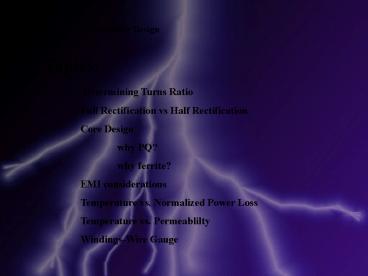Transformer Design - PowerPoint PPT Presentation
1 / 9
Title:
Transformer Design
Description:
Assuming that efficiency will be 80 % Assuming ... voltage drop across diode approximately 2 volts. Core Design-Why PQ? ... too thin will lead to overheating ... – PowerPoint PPT presentation
Number of Views:4403
Avg rating:3.0/5.0
Title: Transformer Design
1
Transformer Design
Topics Determining Turns Ratio Full
Rectification vs Half Rectification Core Design
why PQ? why ferrite? EMI considerations Tem
perature vs. Normalized Power Loss Temperature
vs. Permeablilty Windings-Wire Gauge
2
Determining the Turns Ratio
Assuming that efficiency will be 80 Assuming
duty cycle will be 0.9 (0.45 for each side) Vout
will be 450 volts Vin will be 12 volts (N2/N1)
will be 501
3
Full Rectification vs. Half Rectification
voltage drop across diode approximately 2 volts
4
Core Design-Why PQ?
PQ cores among the best design for EMI reduction
-necessary to meet restrictions Large surface
area compared to volume allows for better heat
dissipation Disadvantage-more expensive design
5
Core Design-Why Ferrite?
fewer turns needed on primary better
coupling lower permeability low flux
density-allows for quicker resetting in this
application, DC saturation not a big issue
6
EMI considerations
Spikes caused by short duration charging and
discharging of parasitic capacitance in
components PQ core Core Gapping Reduced Flux
Density increased primary turns increasing core
area Double Shielding Technique
7
Temperature C vs. Normalized Power Loss
8
Temperature (C) vs. Permeability
9
Windings-Wire Gauge
Skin-depth effect in the wire allows for thin
gauge -allows for transformer minimization -too
thin will lead to overheating Number of turns on
primary inversely proportional to the core
area -because turns ratio is large, opt for a
slightly larger core area Twisting together thin
bundles of wires reduces parasitics for
secondary Liszt wire and copper foil or strapping
might be used for primary Industry practice is to
operate at 450 Arms/cm2































